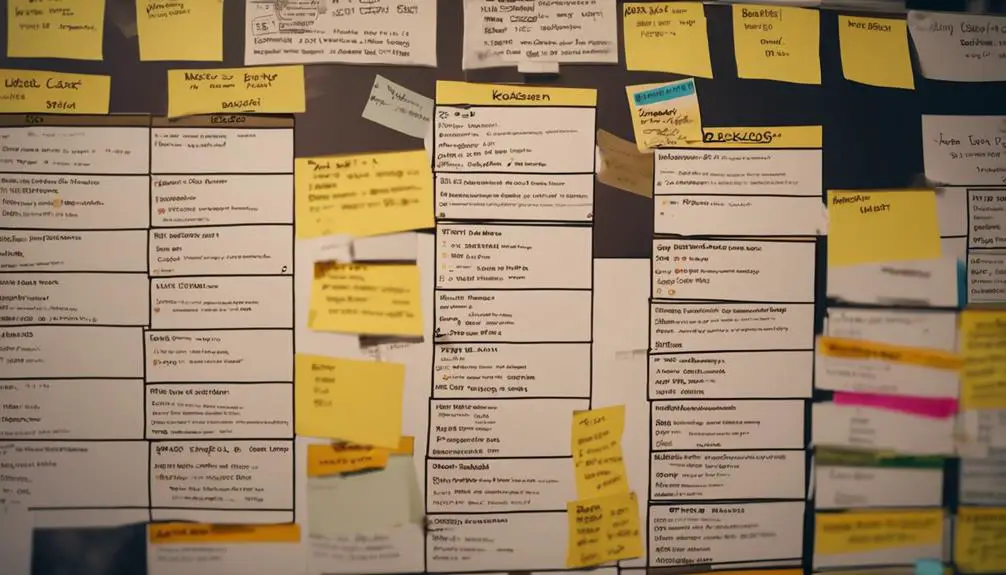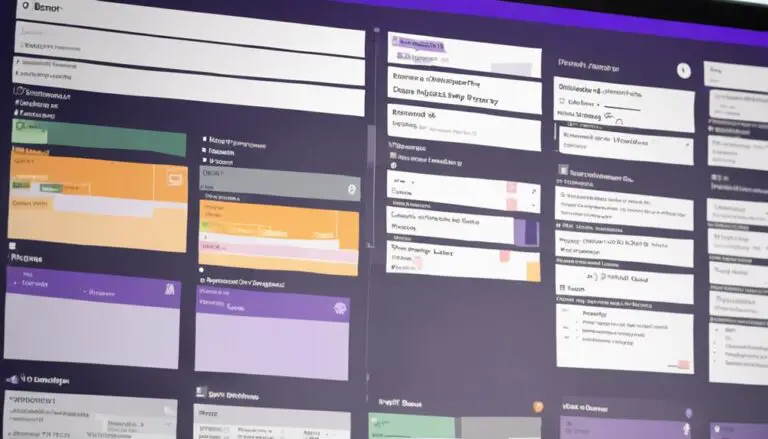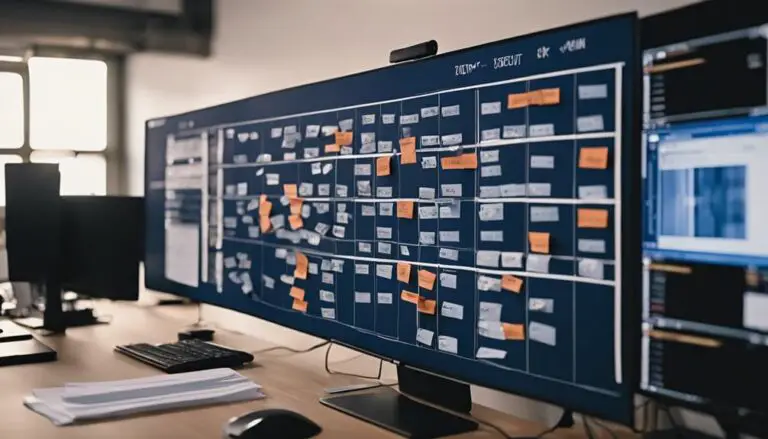In Kanban, the concept of backlog refinement plays a pivotal role in maintaining a well-structured workflow.
Imagine a scenario where your team is gearing up for a new sprint, and the backlog is overflowing with tasks waiting to be refined.
You might wonder, does Kanban have specific strategies for efficient backlog refinement?
By exploring best practices and expert tips in this area, you can uncover valuable insights that could significantly impact your team's productivity and project outcomes.
Key Takeaways
- Backlog refinement is essential in Kanban for clear prioritization and workflow alignment.
- Effective backlog management practices include regular grooming and task breakdown.
- Prioritization drives efficient task handling and ensures project success.
- Streamlining the backlog process with visual management enhances team collaboration and workflow efficiency.
Importance of Backlog Refinement in Kanban
In Kanban, the importance of backlog refinement can't be overstated as it ensures clearer work prioritization and alignment with team goals. When your team engages in effective backlog refinement practices, it not only leads to a more organized workflow but also enables better adaptation to changing priorities. By regularly refining your product backlog in Kanban, you empower your team to focus on high-value tasks and maintain productivity levels. This process is crucial for enhancing task transitions, streamlining workflow, and ultimately achieving better outcomes for your project.
Kanban's emphasis on continuous improvement is evident in the way backlog refinement aids in creating a visual representation of tasks, making it easier to organize and prioritize them. Through this collaborative effort, your team can ensure that everyone is on the same page regarding the work that needs to be done, fostering a sense of unity and shared purpose. Embracing best practices in backlog refinement not only enhances efficiency but also nurtures a culture of teamwork and achievement within your organization.
Effective Backlog Management Practices
To effectively manage your backlog in Kanban, prioritize regular grooming sessions where you break down tasks, add details, and align priorities for streamlined workflow progression. By focusing on refining your backlog items, you ensure that they're well-prepared for development and move smoothly through your Kanban board stages.
Breaking down work items into smaller tasks not only adds clarity but also aids in better understanding and estimation of effort required for each item. Adding details to these tasks helps in providing a comprehensive view for the team, reducing ambiguity, and facilitating a more efficient development process.
Prioritizing tasks within the backlog ensures that the team is always working on the most important items first, enhancing productivity and alignment with project goals. Embracing these effective backlog management practices in Kanban fosters a culture of continuous improvement, collaboration, and optimized workflow progression.
Streamlining the Backlog Refinement Process
Visualizing and managing the flow of backlog items through different stages in Kanban is key to streamlining the backlog refinement process. Utilizing Kanban allows for a structured approach where backlog items progress through columns like Backlog, Assess, Investigate, Refine, and Done.
Involving both the Product Owner and the Development Team in backlog refinement meetings ensures a collaborative effort in grooming and preparing items for sprints. By using Kanban, the team can organize and prioritize backlog items efficiently, resulting in a streamlined refinement process.
The Backlog column serves as the starting point, and as items move through each stage, they become more refined and ready for implementation. This collaborative approach not only aids in maintaining a continuous workflow but also fosters efficient team collaboration.
Role of Prioritization in Backlog Refinement
When it comes to backlog refinement, prioritization plays a crucial role in determining the order of items to be tackled. Prioritizing tasks based on their importance and value helps keep the team focused on delivering high-priority items that align with project objectives.
This practice ensures that critical tasks are addressed first, leading to efficient sprint planning and successful project execution.
Priority in Backlog
Prioritizing tasks in the backlog based on business value and customer needs is crucial for ensuring the team focuses on the most important items first. By assigning priority to backlog items, the team can align their efforts with the project objectives and goals, maximizing efficiency in sprint planning and resource allocation.
This process not only maintains the focus and cleanliness of the backlog but also ensures that the team is consistently working on the most valuable tasks. As a team, regularly review and adjust priorities in response to changing requirements and feedback.
This collaborative approach empowers team members to work on priority items that contribute significantly to the project's success and overall business value.
Order of Items
To maintain the momentum of backlog refinement, ensuring a clear order of items based on value, urgency, and dependencies is paramount for guiding the team towards efficient and effective outcomes.
Prioritization within the product backlog helps in focusing on high-value items first, optimizing workflow, and maximizing productivity during refinement sessions.
By prioritizing backlog items, you can direct the team's efforts towards the most critical tasks, ensuring that project requirements are met effectively.
Regularly reassessing and adjusting the prioritization of backlog items as project needs evolve is essential for staying aligned with the project goals.
Enhancing Workflow With Proven Strategies
Enhance your team's workflow in Kanban by implementing proven strategies that emphasize continuous improvement and efficiency. To optimize your Kanban workflow, consider the following strategies:
- Regular Backlog Refinement: Schedule ongoing refinement sessions where Product Owners, Scrum Masters, and team members collaborate to review, prioritize, and detail work items in the backlog.
- Visualize Workflow: Utilize Kanban boards to visualize the flow of work, identify bottlenecks, and streamline the refinement process for enhanced efficiency.
- Maintain Ready Items: Ensure that backlog items are well-defined and ready for implementation to facilitate smooth workflow transitions and reduce delays.
- Feedback Loops: Establish feedback mechanisms within the team to gather insights on the refinement process, identify improvement areas, and continuously enhance workflow practices.
Optimizing Project Outcomes Through Kanban
You can enhance your project outcomes with Kanban by incorporating outcome-driven strategies and continuously improving your workflow techniques.
By focusing on optimizing project outcomes through Kanban, you can ensure that your team is consistently striving towards achieving success.
Implementing continuous improvement practices will help you adapt to changes efficiently, leading to smoother workflows and ultimately better project outcomes.
Outcome-Driven Kanban Strategies
Optimizing project outcomes through Kanban involves strategically aligning workflow management with the desired results to drive successful implementations. When employing outcome-driven Kanban strategies, consider the following:
- Value Delivery: Prioritize work based on the value it brings to the customer to ensure meaningful outcomes.
- Continuous Improvement: Embrace a culture of adaptation and enhancement to continually refine project results.
- Visualizing Work: Utilize visual tools to track progress and identify bottlenecks for smoother workflow management.
- Feedback Loops: Implement feedback mechanisms and key metric tracking to refine and improve outcomes effectively.
Continuous Improvement Techniques
Improving project outcomes with Kanban involves iteratively refining processes to drive success and efficiency. Continuous improvement techniques play a crucial role in optimizing project outcomes through Kanban.
Ongoing refinement of backlog items, prioritizing high-value tasks, and visualizing work are key aspects to focus on. By regularly reviewing backlog items, teams can adapt to changing requirements and enhance flow. Utilizing practices like limiting work in progress and following the 'stop starting, start finishing' principle can further boost efficiency.
During sprint planning meetings, teams can discuss backlog refinement strategies and identify areas for improvement. Embracing these continuous improvement techniques in Kanban can lead to enhanced productivity and better project outcomes.
Frequently Asked Questions
How Do I Manage My Backlog in Kanban?
To manage your backlog in Kanban, start by prioritizing tasks based on importance. Align priorities with team goals for effective time management. Use agile planning techniques to organize tasks and ensure efficient task organization.
Does Kanban Have a Product Backlog?
In Kanban, you won't find a traditional product backlog, but fret not! Instead, work items are pulled from a prioritized queue on the Kanban board. Embrace the flow, focus on continuous improvement, and optimize your workflow.
What Happens During Backlog Grooming in Kanban?
During backlog grooming in Kanban, you prioritize tasks, involve stakeholders, and use methods like story mapping and estimation to refine items continuously. This collaboration ensures smooth workflow and readiness for development.
What Is the Difference Between Kanban and Scrum Refinement?
Explore the Agile process differences between Scrum refinement and Kanban principles. In Scrum, scheduled meetings guide continuous improvement. Kanban, on the other hand, focuses on just-in-time refinement within workflow optimization for adaptability and flow.
Conclusion
As you continue to refine your backlog in Kanban, remember that the key to success lies in constant improvement and adaptability. By following best practices, prioritizing effectively, and optimizing your workflow, you can ensure that your team is prepared for successful sprints and project outcomes.
Embrace the process, seek feedback, and always strive to enhance your backlog refinement techniques to achieve greater efficiency and productivity in your Kanban system. One way to improve backlog refinement techniques is to regularly review and update the kanban board, ensuring that it accurately reflects the current status of tasks and priorities. By understanding how kanban boards work, team members can better visualize their workflow and identify opportunities for improvement. Additionally, seeking feedback from team members and stakeholders can provide valuable insights for refining the backlog and optimizing the kanban system. Overall, embracing a continuous improvement mindset and actively seeking ways to enhance backlog refinement techniques will lead to a more efficient and productive workflow.





